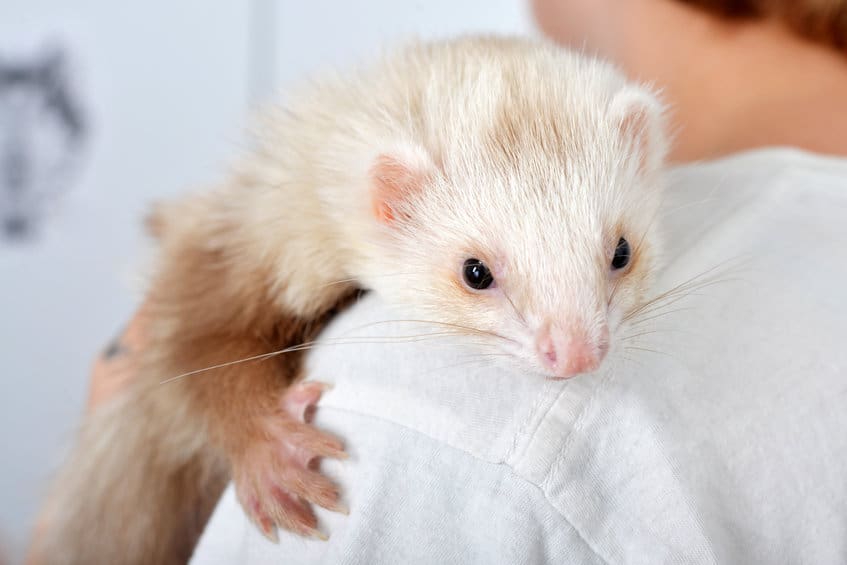Ferrets are rather easy pets to care for as long as you train them right from the start. In addition to training your ferret to behave in certain ways and not nip, you will want to litter train your ferret so that you are not constantly cleaning up accidents around your house and in your ferret’s cage. The key part of training a ferret to use a litter box is to move accidents into the box to help him create the correct associations. From there, you will simply want to pay attention and reward your ferret with a treat every time he uses the litter box.
In the rest of this article, you will find a more in-depth guide about how to train your ferret to use a litter box. You will find instructions about both setting up a litter box and then training your ferret to actually use it. You will also find an FAQ section to answer some other common questions related to litter training your ferret.
Setting Up The Litter Box in 4 Steps
1. Step One: Pick Out A Safe Litter
When you go to the pet store to order litter, you cannot just pick out any litter to use as they are not all safe for ferrets. Because ferrets tend to roll around and sniff their litter, some substances such as clay can hurt their very sensitive respiratory systems. The best kind of litter for ferrets is dust-free and unscented litter. You also want to avoid any clumping litters because while they are convenient, they are not ideal for ferrets.
The best kinds of litter for ferrets are recycled newspaper pellets, denatured wood litter pellets, or alfalfa pellets. In a pinch, you can use an unscented or un-clumping cat litter, but you should always avoid any litter made with cedar as pine shavings. Cedar and pine could irritate your ferret’s eyes in addition to causing respiratory problems.
2. Step Two: Pick Out A Litter Pan
You need to make sure that you pick out a big enough litter pan, or your ferret will not use it. The litter pan has to be big enough that your ferret can easily fit all four of his paws into the litter pan and still be comfortable. You also want to ensure that it has low sides so that your ferret can get in and out of the litter pan easily.
3. Step Three: Place The Litter Pan In The Cage
It is best to start litter training in your ferret’s cage and move it out later if you want rather than the other way around. You should place the litter box into the corner of your ferret’s cage away from food and water. They make triangle litter boxes just for this purpose. At this point, you should also make sure that there is no litter anywhere else in your ferret’s cage.
4. Step Four: Move Some Feces and Urine Into The Litter Box
You will need to take some urine and feces from elsewhere in your ferret’s cage and put them in the litter box. Ferrets, unlike cats, do not naturally use their litter box due to instinct. By moving urine and feces into the litter box, you will be showing your ferret what that area is for.
Potty Training Your Ferret in 4 Easy Steps

5. Step Five: Start In The Cage
As previously mentioned, you should start litter training your ferret in the cage. Furthermore, until your ferret is completely litter trained, you will likely want to keep your ferret in the cage when unsupervised so that you do not end up with too many accidents to clean up. Whenever you see your ferret use the litter box in the cage, you should reward him with a treat. However, you should never shout or punish your ferret for making a mistake.
6. Step Six: Move Accidents To The Litter Box
Your ferret is naturally going to have accidents while you are litter-training your ferret. When he does so, you simply will want to scoop up the accident and move it to the litter box to remind your ferret what that area is for. You also want to clean the area where he had the accident with a smell-eliminating spray, so your ferret does not associate that area with going to the bathroom again.
7. Step Seven: Keep The Litter Box Clean
Your ferret will stop using the litter box if it becomes too dirty or smelly. At least once a day, you are going to want to clean it out with a small litter scooper. You will also want to completely clean out the litter box for a week by dumping the contents and replacing them with new, fresh litter.
8. Step Eight: Place Litter Boxes Outside Of The Cage
Once your ferret is litter training in the cage, you can start letting your ferret out to explore even if you are not there to supervise. You will want to make sure you put at least one litter box in the corner of every room that you allow your ferret to explore.
It should be easier to get your ferret to use these litter boxes, but you will want to follow the same general process:
First, you want to move some feces and urine into the box so that your ferret can smell what it is for. Second, you want to reward your ferret with a treat any time you see him use it. Finally, you should still avoid punishing your ferret for mistakes, even though you may feel more frustrated when on the floor rather than in the cage.
Fixing Common Litter Training Problems
1. Fasten the Litter Box To The Cage
Ferrets commonly dig around in a litter box which can cause the box to slide around or even dump over. Not only does this create a mess, but it might encourage your ferret to go to the bathroom outside of the litter box. By punching holes in the side of the litter box and attaching it to the cage with wires, you will prevent it from sliding around or falling over when your ferret digs. Of course, any sharp edges or wires should face outwards so that your ferret does not end up hurt.
2. Fill Other Corners
If your ferret regularly has accidents in specific corners or areas, place something there. You can choose to place food, water, bedding, or toys in the area. Ferrets are unlikely to go to the bathroom in the same area where they eat, sleep, or play. By changing their association with that corner, you will discourage them from having more accidents.
How Long Does It Take To Potty Train A Ferret?
When you are actually working through the process of potty training your ferret, it can feel like it is taking forever, as it can feel rather frustrating when your ferret is having accidents. However, ferrets are smart little critters and litter training does not usually take very long as long as you are consistent.
Within a week or two, your ferret should be regularly using the litter box and having very few accidents, if any. Nevertheless, you should consistently keep rewarding your ferret for using the litter box for a while after he seems to have it figured out.
At What Age Should You Start Potty Training Your Ferret?
No matter what you are training your ferret to do, it is better to start while your ferret is younger. As the saying goes, it is hard to teach an old dog (or ferret) new tricks. For this reason, you will likely have the most success potty training your ferret if you start working towards it the day you get home.
However, if you do want to litter train an older ferret, it is still possible. It simply might take a bit more time to do so successfully as you are having to break old habits in addition to teaching new ones.
Why Is My Ferret Not Using His Litter Box?
There are a couple of different reasons why your ferret may not be using his litter box. First, you want to consider if you have changed anything. Ferrets can be rather picky creatures, so if you suddenly get a new litter box or change the type of litter you are using, your ferret may decide he does not like it and stop using the box altogether.
If you have not changed anything, you can move on to other possible problems. The second thing to consider is whether or not the litter box is too dirty. If your ferret believes he might dirty himself by getting in the litter box by stepping in old pee or poop, he will find a different spot to go to the bathroom.
Finally, it could be that your ferret is not feeling great and has stopped going to the bathroom altogether or moving around much. If this is the case, you will need to take your ferret to see a vet as soon as possible.
What Are Different Methods of Litter Training?
There are four main different methods/strategies related to litter training. Some of these methods were included in the step-by-step guide, but others were not.
- The first method is called the “Rise and Shine” method. For this method, you will pick up your ferret whenever he wakes up and place him in the litter box. When or if your ferret goes to the bathroom, you will reward him with a treat. With time, your ferret will start going to the litter box when he wakes automatically.
- The second method is called “praise and adulation.” With this method, you will not only reward your ferret every time he uses the litter box, but every single time he approaches or enters the litter box.
- The third method is called the “big bed” method. This method is for when you are really struggling with your ferret having accidents in certain places. If this is a problem for you and your ferret, place some bedding or a hammock in the area or room. Your ferret will not want to go to the bathroom where he thinks he should sleep.
- The final method is called the “follow your nose” method, which can be used with any ferret, even blind ones. Ferrets love the smell of vanilla extract, so by putting vanilla extract around or in the litter box, they will be attracted to the area.
How Do You Manage Litter Smell?
The litter box smell is not pleasant, but there are some things that you can do to help manage the smell. Here are some tips to help you minimize smell:
- Scoop out the litter box at least once a day, if not twice.
- Replace all of the litter regularly.
- Replace the litter box in its entirety once a year.
- Consider trying out litter deodorizer; just make sure that they are ferret safe.
- Place the litter box in a well-ventilated area.
Why Do Ferrets Sometimes Eat Their Litter?
If your ferret is eating his litter, it likely means that he is not getting enough good. Ferrets will continuously eat if you let them, so you do not want to give them access to too much food. However, if your ferret is starting to eat litter or bedding, it is likely time to increase the amount you are giving your ferret at mealtime.
Why Do Ferrets Sometimes Sleep In Their Litter Box?
If your ferret is sleeping in a clean litter box, you do not need to feel overly concerned. It is likely your ferret has just associated the litter box with the wrong thing. However, if your ferret is sleeping in a dirty litter box, it is cause for concern as it might mean that your ferret is depressed. There could be a couple of reasons for this, but the most common is that you are not getting your ferret out of his cage enough. Your ferret should be out of your cage for at least four hours each day.
References and further reading:
- FERRET BEHAVIOR, PETER G. FISHER
Contents
- Setting Up The Litter Box in 4 Steps
- Potty Training Your Ferret in 4 Easy Steps
- Fixing Common Litter Training Problems
- How Long Does It Take To Potty Train A Ferret?
- At What Age Should You Start Potty Training Your Ferret?
- Why Is My Ferret Not Using His Litter Box?
- What Are Different Methods of Litter Training?
- How Do You Manage Litter Smell?
- Why Do Ferrets Sometimes Eat Their Litter?
- Why Do Ferrets Sometimes Sleep In Their Litter Box?













